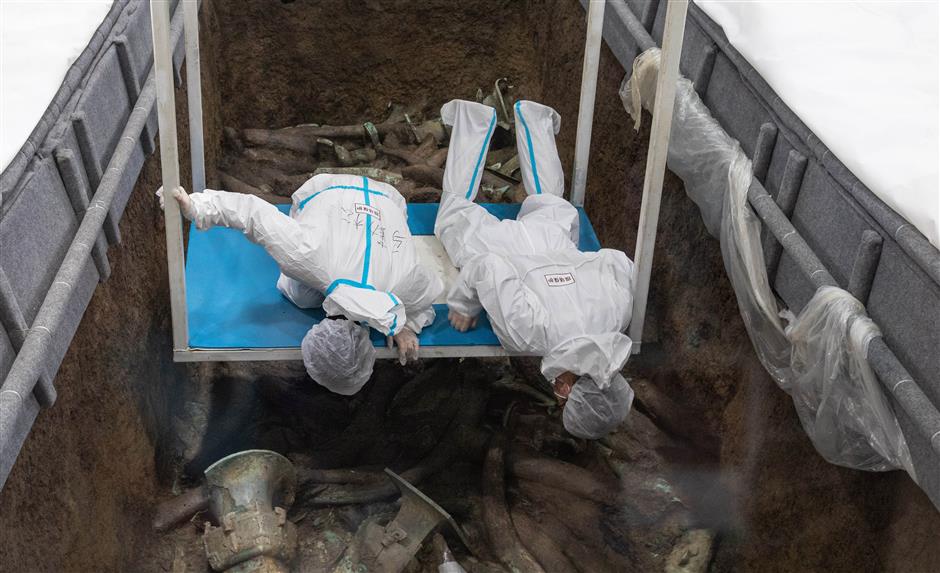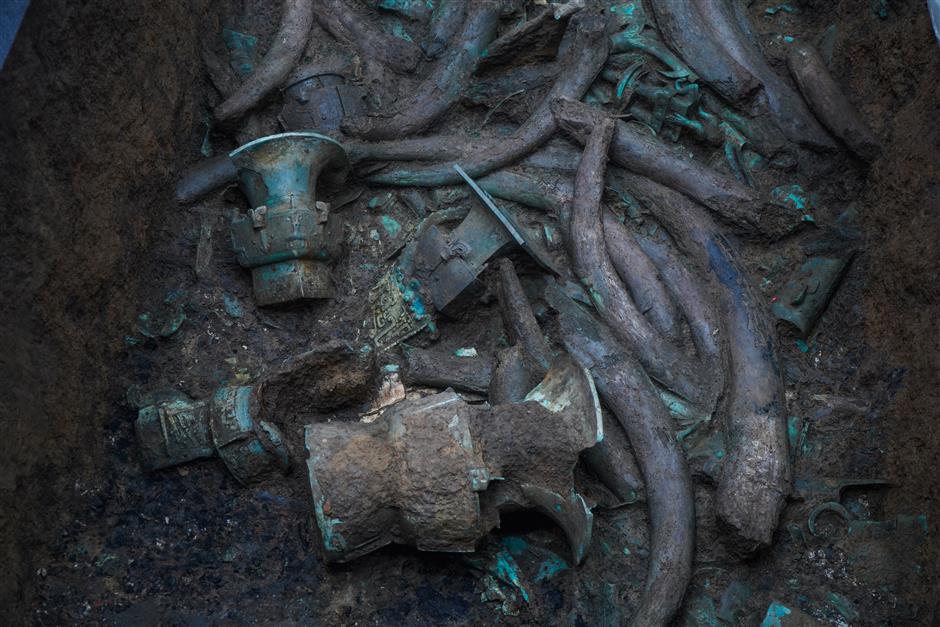Ancient ruins foster exciting new chapter in archeology

A fragment of a gold mask unearthed recently from the Sanxingdui Ruins has caught attention of the public.

The Shanghai University team works at the No. 3 pit of the Sanxingdui Ruins.
Fragments of gold masks, bronze sacred trees, ivory and jade tools unearthed recently at the legendary Sanxingdui Ruins in southwestern China's Sichuan Province have caught the world’s attention via livestreaming of the archeological excavation.
Among the archeologists involved in exploring the remains of a Bronze Age civilization there are teachers and students from Shanghai University.
“We are proud to be able to take part in the amazing project,” said Duan Yong, deputy Party secretary of the university, director of the Shanghai Museum Council and a member of the archeology team.
The Sanxingdui Ruins are considered one of the greatest archeological finds of the 20th century. They were accidentally discovered by a farmer digging a ditch in the 1920s.
The 12-square-kilometer ruins are located in the city of Guanghan, about 60 kilometers from the capital city of Chengdu. They are believed to be the remnants of the ancient Shu Civilization, dating back at least 4,800 years and lasting over 2,000 years.
In 1986, the Bronze Age relics were unearthed in the No. 1 and No. 2 pits at the site, arousing global interest. So far, more than 50,000 relics have been unearthed. The ruins are now a national protection site.
More than 30 institutions participated in the latest round of excavation work. Between November 2019 and May 2020, they found six new rectangular sacrificial pits.
Together, the eight pits give modern mankind a glimpse of how the Shu Civilization offered sacrifices to heaven, Earth and ancestors, and how they prayed for prosperity and peace, according to Tang Fei, head of the excavation team at Sanxingdui and chief of the Sichuan Provincial Cultural Relics and Archeology Research Institute.
The six new pits range from 3.5 to 19 square meters in size, according to the National Cultural Heritage Administration. Archeologists have unearthed more than 500 items dating back about 3,000 years, including fragments of gold masks, bird-shaped gold ornaments, gold foil, painted bronze head portraits, giant bronze masks and other relics.

Archeologists in exposure suits work at the No. 3 pit with modern facilities.

Shanghai University has sent six of its nine archeology teachers to Sanxingdui, Among them is Xu Feihong, who heads up excavation work at the 14-square-meter No. 3 pit. The teachers rotate stints at the site, supported by postgraduate students.
In addition, five experts from the university’s Cultural Relics Preservation Institute have also worked at Sanxingdui or supported their colleagues remotely from Shanghai.
“Our team is small, but highly capable,” Duan said. “The pit is so small that it couldn’t accommodate too many people at one time.”
So far, the No. 3 pit has delivered the largest number and broadest range of relics, including 109 bronze masks, 127 pieces of ivory and eight of jade.
“The excavation work is supported by the most advanced technologies in China or indeed the rest of the world,” Duan said.

A lot of ivory and bronze ware items have been found in the latest round of the excavation work at the Sanxingdui Ruins.

Archeologists collect samples and remove cultural relics out of the No. 3 pit carefully according to strict protocols for excavation and preservation.
Uncovering the history of the Shu people involves many disciplines beyond archeology, including philology, physics, chemistry, biology and material sciences, he added.
The excavation team built cabins with stable temperatures and humidity directly on top of the pits so that unearthed cultural relics could be better preserved after excavation. The whole excavation process is being recorded.
In the cabins and auxiliary labs, the remnants are analyzed. That effort is supported by Sichuan Provincial Cultural Relics and Archeology Research Institute, Sanxingdui Museum and participating universities and research institutions from across the country.
“The excavation process has been carefully planned,” Duan said. “There are different protocols for excavation and preservation of cultural relics of different materials. Even samples of soil and ashes are collected, numbered and sent off for testing.”

Archeologists find in the No. 3 pit a 70-centimeter-high bronze vessel, the largest bronze ware item that has ever been unearthed at the Sanxingdui Ruins.

A large bronze vessel is found in the No. 3 pit at the Sanxingdui Ruins.
The discoveries reveal the distinctive nature of the Shu Civilization and its connection with other areas of China and Asia, said Duan.
“Most newly discovered cultural relics are amazing,” he said. “For example, the huge bronze masks, the bronze sacred tree and the bronze vessel feature the sculpture of a kneeling man.”
Bronze urns, vessels and jade ware show close cultural ties with ancient civilizations on China’s central plains and the lower reaches of the Yangtze River. Gold masks, seashells and gold rods previously unearthed indicate that the Shu may have had contact with civilizations even further afield, in western and southern Asia.
According to Duan, remnants of silk fabric seem to corroborate legendary tales that the Shu invented silkworm cultivation and silk production. They also tend to verify historical records, such as the tale of a king of the Shu carrying jade and silk gifts to a meeting with ancient Chinese emperor Da Yu, and the story of Shu cloth found in what is today's Afghanistan by envoy Zhang Qian in the reign of Emperor Wu of the Han Dynasty (202 BC-AD 220).
They also corroborate other archeological findings, such as armlets made of Shu cloth unearthed in the northwestern Xinjiang Uygur Autonomous Region of China, and a Han Dynasty wooden loom found in another Sichuan excavation site.
“Many experts,” Duan said, “are talking about whether we will find writing, as was the case with pits built during the late period of the Shang Dynasty (16th-11th centuries BC), when inscriptions on bones and bronze objects already appeared in the central plains. Since Sanxingdui seems to reveal a close connection with that area, it is possible.”

-

-

-

-

-

-

Some cultural relics unearthed earlier at the Sanxingdui Ruins are now on display at the Sanxingdui Museum.
-

Livestreaming of the current excavation, accompanied by commentary from experts, has prompted public discussions online. Some web users have created funny emoji with photos of unearthed gold and bronze masks.
Duan said the excavation is a good way to celebrate the 100th anniversary of modern Chinese archeology, which started in 1921 when the Yangshao Ruins were first excavated in Henan Province.
“Archeology is a science that often seems mysterious and remote to the public,” Duan said. “But actually, it is quite relevant to us. It helps us learn who we are and where we came from. It also reveals connections between ancient civilizations and contemporary communities.”
Duan noted that UNESCO has appealed to residents living near excavation sites to keep abreast of findings and how that heritage is interpreted and relates to modern life. The United Nations agency urges everyone to work to protect such history.
“Public archeology is developing in China and across the world,” he said. “The digital era creates online awareness and discussion, and poses a challenge for archeologists to use new media to demystify their work and findings.”
He said the popularity of the Sanxingdui excavation may also encourage more students to major in archeology and seek careers in a field not associated with high pay.
Shanghai University was one of the earliest Chinese universities to offer archeology courses. In 1980, it launched a branch of archeology for history majors. Its students have participated in archeological digs in the Three Gorges area of the Yangtze River and at the Guangfulin relic site in Shanghai.
In 2018, the Ministry of Education approved a university request to initiate a separate master's degree in archeology. This year, its bid for a bachelor’s degree in the discipline was approved – the only such program in Shanghai. The first undergraduate students will be enrolled in the September term.
“We will develop our archeology program in unique ways,” said Duan. “For example, with the university’s strength in unmanned surface vehicles, we will develop studies on mountain and ocean archeology. Our participation in the Sanxingdui excavation is a testament to our capability.”















